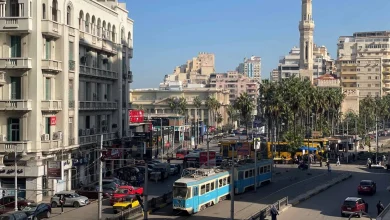Will life return to the ancient Ibn al-Nabih cistern in Alexandria?
In the heart of ancient Alexandria, where archaeological monuments are scattered among narrow alleys and heritage buildings, stands the Ibn al-Nabih cistern, one of the oldest and most important examples of Islamic architectural genius, which has stood for nearly 600 years.
However, instead of being a cultural and historical attraction, its surroundings have turned into a garbage dump and a gathering place for scavengers. Its historic sign has been thrown inside the walls, replaced by a commercial advertisement! The site is locked, with no development plan or even a sign informing visitors about the cistern’s history and significance.
Environmental and archaeological violations… Garbage removed after repeated complaints
Tamer Zaki, an archaeological expert, says he has filed several complaints with a number of relevant authorities to improve cleanliness around the archaeological cistern. The area has become a gathering place for scavengers who are constantly present in front of the site, in clear violation of archaeological and environmental laws. They sort through the trash in the bins in front of it. He adds, “Finally, our complaints were heard and the trash bins were removed from around the cistern.”
He emphasizes that the Ibn al-Nabi cistern is one of the most important public cisterns in the city of Alexandria. These are public cisterns that served the general public without being linked to a specific facility. The cistern has been registered as an Islamic and Coptic monument since 1951 by Decree No. 10357. It is considered one of the most important and largest cisterns dating back to the Islamic era.
Rare Islamic architecture… The cistern that stored life
The Ibn al-Nabih cistern is one of the most prominent historical water reservoirs in Alexandria. The city relied on it to store water for drinking, cooking, watering animals, and other daily purposes.
The cistern consists of three floors below ground level and measures approximately 11 x 13 meters. It has about 48 granite columns, distinguished by their capitals, bases, and bodies of different styles.
Some of them bear Christian symbols and signs, leading some to believe that the site dates back to the Roman era. However, Islamic architecture often reused the ruins of ancient buildings, which is a common practice in some Islamic styles.
Ibn al-Nabih: Judge and scholar of the city
The cistern is attributed to Muhammad ibn Muhammad ibn Ahmad ibn Salih ibn Hassan, known as Ibn al-Nabih, who died in 862 AH. He was a scholar of religion and worldly affairs in the ninth century AH. He worked as a judge in the city of Alexandria and was known among its people for his virtue and righteousness, so the cistern was named after him to commemorate him.
Alexandria needed water cisterns to store drinking water and water for daily use. For this reason, cisterns spread throughout the city and varied between public and municipal. Public cisterns were isolated cisterns that served the city as a whole. Municipal cisterns were attached to specific buildings such as mosques, agencies, and houses.
The cistern underwent several restoration projects, the first of which was carried out in 1892 by the Committee for the Preservation of Arab Monuments. Its remains are clearly visible on the third floor of the cistern in the form of distinctive stone blocks. In 2007, a French mission worked on restoring other parts of the site. Some excavations were completed to uncover the roof of the cistern, and modern additions were removed, restoring it to its original state.
“The Biography of Alexandria”: a new path to save the cistern
Mina Zaki, founder of the “Biography of Alexandria” initiative, explained that the initiative recently launched a special tour of Sultan Hussein Street to highlight its architectural beauty and ancient buildings, as well as the biographies of those who witnessed it.
He emphasized that one of the most important goals of this route is to restore and open the Ibn al-Nabi cistern to the public. In addition, informative signs will be posted to raise awareness of all the street’s historical sites. He expressed his dissatisfaction with the replacement of the original sign indicating the location of the cistern with a commercial advertisement and the throwing of the historical sign inside the walls.
He noted that he had personally contacted a number of Alexandrian businessmen to discuss the idea of financing the restoration of the cistern, opening it to visitors, and installing new information signs, especially since the cost of restoring the site is not high compared to its historical value. Although the idea was welcomed, he has not yet received a final response to begin work.
A testament to the genius of Alexandria’s water systems
Engineer Magdy Sabbagh, a specialist in architectural heritage, spoke about the Ibn al-Nabi cistern, emphasizing its great archaeological and tourist value due to its location in the middle of an archaeological and historical area. This area includes the Waterfalls Park and Tabia al-Nahasin.
He stressed the importance of reopening the cistern after its restoration and securing it, and converting it into a museum displaying the water supply systems of ancient Alexandria. This is because it embodies the genius of the city’s water system and is a testament to an advanced engineering system that was ahead of its time. He added: “This knowledge must be passed on to the Alexandrian community and tourists, as the place is a real archaeological treasure.”
He continued: “The cost of restoration and rehabilitation is relatively reasonable, and the place is really worth a lot to us. There are already organizations interested in Alexandria’s heritage that have prepared a project to revive the cistern. It has already been presented to the Ministry of Antiquities, but so far no official action has been taken. This is a great loss for tourism in Alexandria.”
A water museum… a postponed project waiting to get off the ground
Architect Dr. Mohamed Adel Al-Desouki recalls the history of Alexandria, explaining that since its founding by Alexander the Great, the city has needed cisterns to supply water to its inhabitants.
It is said that there were about 700 cisterns serving the city. However, very few of them remain today, with only five cisterns registered as historical monuments. These include the Green Gate Cistern, the Ibn Battuta Cistern in the Kom al-Nadoura area, the Mabamah Cistern, and Dar Ismail. The Ibn al-Nabi Cistern is considered the most important and largest in terms of architectural style.
Al-Desouki discusses the issue of reopening the Ibn al-Nabih cistern, saying, “Opening the cistern is not an easy matter and requires careful consideration of how to do so: Will it be open to visitors and the public? Will it be part of a museum exhibition? Or will we simply improve the surrounding area so that visitors can view it from outside? The idea needs careful study.”
He added that the French Center for Alexandrian Studies had prepared a proposal years ago to establish a museum on the history of water in Alexandria, pointing to the city’s rich history and the importance of showcasing it to the public. The great Alexandrian architect Dr. Mohamed Awad has also put forward a similar proposal, which includes the construction of a building and museum specializing in the history of water, featuring all the architectural and hydraulic details. Unfortunately, however, none of the proposals have seen the light of day to date.
Attempts and ideas to save the ancient Ibn al-Nabi cistern
Al-Desouki adds that he is currently witnessing several attempts, proposals, and ideas to reuse this unique cistern.
These have been issued by various Alexandrian research bodies. Although there are other cisterns in different Egyptian cities, the Ibn al-Nabi cistern is distinguished by its unique architecture and size, which make it unique.
He affirms that the Egyptian Ministry of Antiquities is interested in reviving this important archaeological landmark in the history of Egypt in general and Alexandria in particular. He points out that the geographical location of the cistern makes it even more distinctive, as it is in the heart of the city and is a rare architectural structure. He also draws attention to the current flow of research and community efforts to revive the cistern, expressing his hope that these attempts will be crowned with success through careful scientific study.
A decisive decision awaits
Amid these research efforts, community initiatives, and multiple restoration proposals, the decisive decision remains pending. Al-Desouki concludes by saying, “The cistern needs funding, scientific study, and official will.”
This unique archaeological landmark is unparalleled and represents a golden opportunity to revive a part of Alexandria’s aquatic and architectural history in the heart of the city.
Read also
“In the Presence of the Makam”: A Research Project to Document the Memory of the Mariout Lake Area
“The Golden Smile” Exhibition: When Fragility Becomes Art and Resistance Becomes Features









Hi, this is a comment.
To get started with moderating, editing, and deleting comments, please visit the Comments screen in the dashboard.